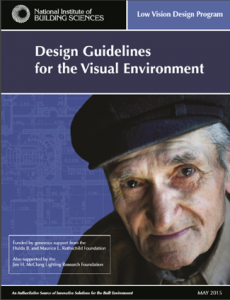Lighting: Follow the Research!
By Jane Rohde
Introduction
This month, Sunbrella is bringing to you; Lighting: Follow the Research! There are very special moments that center around light coming through a window where a cat finds a sunbeam and curls up for a nap or that magical moment when you feel the sun warming your back while a fresh breeze gently brushes across your face. There is a reason why people seek out daylight and sunshine â not only for the pleasure of being in the sun and the warmth, but because natural body systems are supported by access to daylight.
Lighting Research
Research regarding natural light and older adults has been championed by the Lighting Research Center at Rensselaer Polytechnic Institute’s Mariana G. Figueiro, PhD and Mark S. Rea, PhD. There is general research and lighting principles for older adults available at https://www.lrc.rpi.edu/programs/lightHealth/LightOlderAdults.asp. Changes occur to the visual systems as residents age and can decrease ability to see, impact balance and stability, and impact the circadian system as it relates to the quality of sleep. Utilization of daylight and artificial sources of light can be used to stimulate the circadian rhythm to improve sleep, increase visibility while completing tasks, and reduce fall risk. There is a resource based upon the research completed called Lighting Patterns for Healthy Buildings that can be utilized by design professionals to improve their lighting design and placement for positive outcomes by residents, patients, and staff. For example, for a nursing station there is a Base Case provided for reference, and two redesigns with descriptions; one with Circadian Stimulus (CS) that is static and one that is color tunable. The information on the website (http://lightingpatternsforhealthybuildings.org/) is available for various types of senior living, healthcare, and educational spaces.
With the on-set and popularity of a health and wellness focus for workers, as part of the sustainable design of buildings, the General Services Administration (GSA) has completed research on circadian light that found that office workers who received the most circadian stimulation at work during the daytime, slept an average 30 minutes longer at night.[1] This in conjunction with a recent RAND study on sleep estimated that the US loses an equivalent of about 1.23 million working days per year due to sleep loss, translating to an economic cost of $9.9 million per year.[2] These data could support a business case for investing in circadian effective light in daytime work environments â including healthcare settings. With the high turnover and stress for healthcare workers, the provision of circadian effective light could support staff through various shifts for better performance and healthier individual outcomes.
The two popular rating systems used for the evaluation of Health and Wellness attributes including daylighting and access to views are the WELL Building Standard® and FitwelSM. WELL is available through the International WELL Building Institute and administered through GBCI, the certification and credentialing organization for USGBC (LEED®). FitwelSM was developed by the Centers for Disease Control and Prevention (CDC) and GSA. After the completion of over 80 pilot projects, FitwelSM is now administered by the Center for Active Design. As of the beginning of November 2017, there are 59 current projects certified or in-progress and over 600 committed projects anticipate in 2018.
Standards and Guidelines
There has been an update to the Illuminating Engineering Societyâs Standard Lighting and the Visual Environment for Seniors (IES RP-28-16) that includes guidance as well as recommended foot candle levels for designing of various types of spaces within a senior living setting. The companion standard, Lighting for Hospitals and Health Care Facilities (IES RP-29-16) has also been updated and includes guidance and foot candle levels for spaces found in hospitals and outpatient facilities. Both standards are referenced in the three 2018 Facility Guidelines Institute (FGI) books; Guidelines for the Design and Construction of Hospitals, Guidelines for the Design and Construction of Outpatient Facilities, and Guidelines for the Design and Construction of Residential Health, Care, and Support Facilities.
Within all types of healthcare settings, most users are over the age of sixty-five. When designing environments for those with low-vision, the outcomes are good for all users of a setting â including such attributes as reduction of glare by using indirect lighting solutions, providing even lighting on all types of walking surfaces, and providing adequate light levels to easily read and understand information provided by healthcare practitioners. The recommended resource available as a free download is the Design Guidelines for the Visual Environment completed by the National Institute of Building Sciences (NIBS). This document is also referenced by the FGIâs Guidelines for Design and Construction of Residential Health, Care, and Support Facilities and recommended by the Mayer-Rothschild Foundation.

Conclusion
Research is having an important impact on lighting design for healthcare environments. Coupled with the development of tunable LEDs, sensors to control daylighting within healthcare spaces, and designing buildings with easy and safe access to outdoor areas, the opportunity to improve patient, resident, and staff outcomes is clear! Become a champion of good lighting design as it supports quality of life!
[1] Figueiro MG. (2017). The impact of daytime light exposures on sleep and mood in office workers.
Sleep Health. 2017 Jun;3(3):204-215. https://www.ncbi.nlm.nih.gov/pubmed/28526259
[2] RAND Corporation, 2016. Why Sleep Matters: The Economic Costs of Insufficient Sleep https://www.rand.org/randeurope/research/projects/the-value-of-the-sleep-economy.html

Jane Rohde is the founding Principal of JSR Associates, Inc. located in Catonsville, Maryland. JSR Associates, Inc. celebrates 22 years of consulting services in 2018. She champions a global cultural shift toward de-institutionalizing senior living and healthcare facilities through person-centered principles, research and advocacy, and design of the built environment. Jane is the recipient of the 2015 Environments for Aging Changemaker Award and speaks internationally on senior living, aging, healthcare, evidence based design and sustainability. For more information or comments, please contact Jane Rohde at jane@jsrassociates.net.